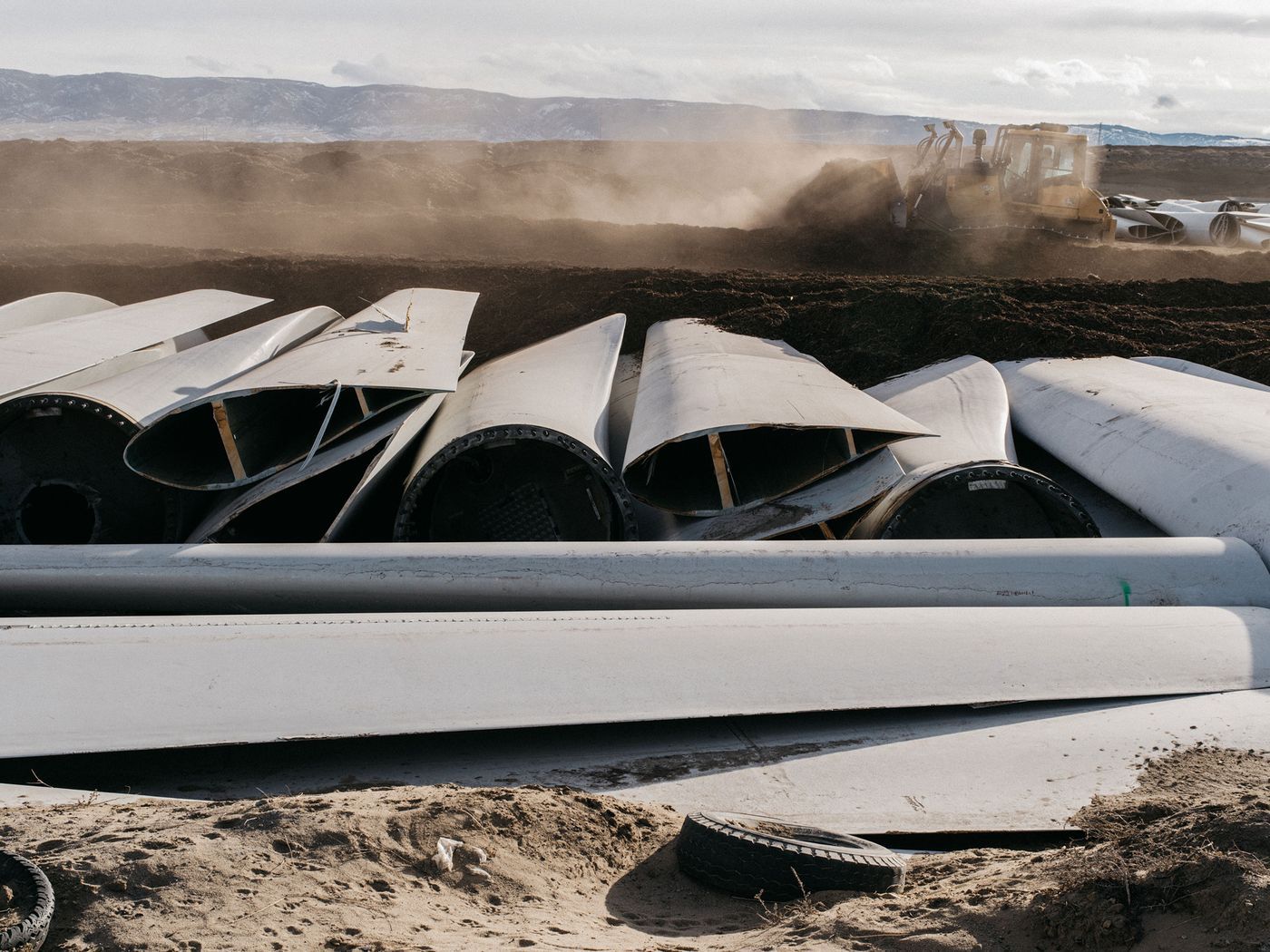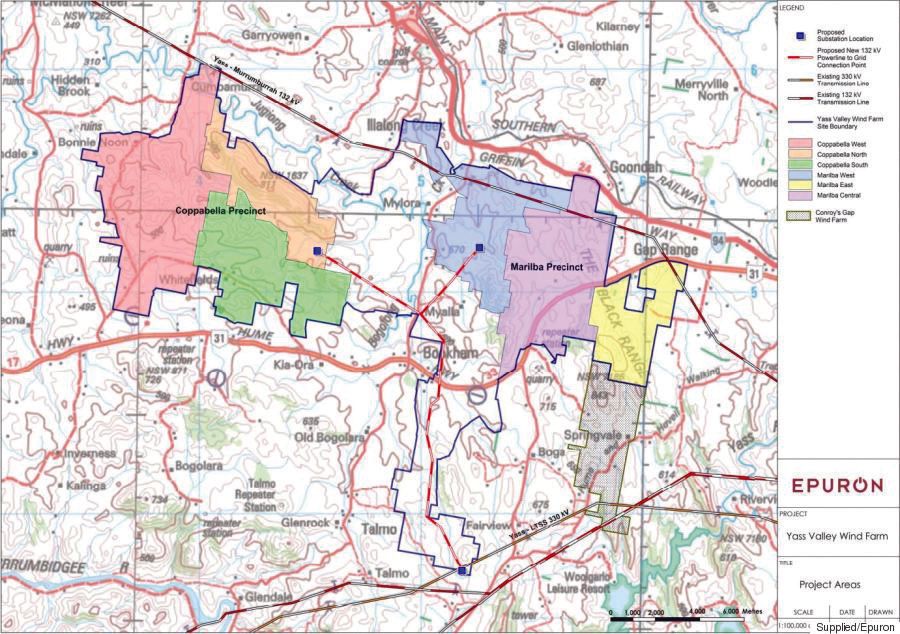Wind turbine blades are non recycleable
Yass Landscape Guardians • October 27, 2020
While the energy generated by wind turbines is clean and green, outdated turbine blades are not.
With blades spanning up to 260 feet and weighing an average of 36 tons, old or broken blades pose a difficult disposal problem around the world.
Currently, there are two common disposal methods for turbine blades – burning them or throwing them in a landfill. According to NPR, more than 720,000 tons of blade material will be disposed of over the next 20 years. With an increasing dependence on wind-generated electricity and the ever-growing size of the turbines themselves, the issue of waste from wind turbines is one that cannot be ignored.
Turbine blades are difficult to recycle
On average, wind turbines are designed to last approximately 20 to 25 years. The majority of wind turbines are made from steel and copper, which are widely recyclable materials. However, the blades of these turbines are a different matter entirely.
Turbine blades tend to be made from composite glass or carbon material. Unlike steel and copper, these materials are not as valuable when recycled, so many turbine owners turn to less green disposal methods, such as disposing of decommissioned blades in landfills.
Owners of wind turbines frequently pay for collection services to transport the massive blades to landfills. However, because of their size and weight, turbine blades typically need to be cut up before they can be moved. Disassembling these blades generates increased time and energy spent simply on disposal.
Once they reach the landfill, the turbine blades take up a large amount of space. Municipal landfills across the country have encountered issues with finding enough space for the massive number of blades while maintaining room for other forms of waste.
Source: Choose Energy
The Issue
We can expect 700 oversized and overweight loads will be delivered to Coppabella.
All of these 700 envisaged oversized and overweight loads will close the Hume Highway as they turn into Whitefields Road Goldwind's approved access point for construction of Coppabella.
Added to this all the police escorts and associated escort vehicles, a massive onterarge that the taxpayer is funding?
The Bango blades are 71 meters long unsure of the weight but referencing the site that disclosed that at the Dundonnell blade a is 73M blades and are 70 tonnes each in weight.
Thus for Bango at 71M the weight will be negligible less, and Coppabella at 70M very marginally less in weight.
Equates in round figures to 210 tonnes per tower of non recyclable balde. Our question is where will all this waste end up?

Photographer: Benjamin Rasmussen for Bloomberg Green

The Daily Telegraph has reported that the “Beijing-based Xinjiang Goldwind Science & Technology Co, part owned by the Chinese Communist government, plans to build 75 wind turbines in Yass Valley through its Australian arm, Coppabella Wind Farm Pty Ltd. Neighbours are up in arms about environmental hazards and visual pollution, but the project has planning approvals. Affected residents also say the issue has become divisive in local Bookham and Binalong, with the company handing out $287,500 a year in community grants, which they slam as “bribes”. Experts have raised fears about companies linked to the Chinese government owning any part of the electricity infrastructure. The Coppabella turbine blades will reach 171m high and the 70m blades will turn at the outer tips at speeds surpassing 300km/h. Neighbour Noeleen Hazel, who with husband Bruce has lived for almost 60 years at their farm Kia Ora in Bookham, next door to one of the sites, says the situation is “devastating”. “It will deface the unique landscape of the Coppabella Hills and cause environmental carnage,” she says. “We’ve been fighting this for years, we can’t believe it was approved. It’s split the communities — any project needing to pay ongoing bribes to receive support obviously lacks authenticity.” Among others who oppose the project, local John McGrath raised concerns about the changing air pressure on birds, asking: “If city people want this stuff why don’t they put it on Bondi Beach?” China expert Professor Clive Hamilton said Australia’s electricity industry should be regarded as “critical infrastructure”. “Ownership of any part of the electricity industry by a company linked to the Chinese government is a risk to national security,” he said. “Chinese law requires every Chinese company to assist China’s intelligence services if asked. The Treasurer should prevent any state-linked Chinese company from having a role in Australia’s electricity supply.” In 2017, the independent Planning Commission received 100 submissions on the project, including 82 objections and five in support. Goldwind has agreements from the owners of 25 non-associated residences near the project, where landowners accept the visual impacts. Goldwind Australia managing director John Tichen said once completed it would deliver enough power to supply the equivalent of 173,000 NSW homes each year. “The project is expected to employ more than 200 people during construction and have up to 10-15 permanent maintenance staff when fully operational,” he said, adding potential social and environmental impacts had been “comprehensively assessed”. Daily Tele. An April 2016 story by the Times contains details that Epuron, the original applicant had gained approval from the New South Wales Department of Planning. On February 1 2017, Goldwind purchased what is essentially development approval from the Australian company Epuron. Epuron’s original proposal was for 152 turbines located across three distinct precincts and transmission infrastructure in a fourth. The number of turbines was subsequently reduced to 124 turbines. According to Epuron, “ It is one of Australia’s most successful wind farm developers. It has developed the highest yielding wind farm, largest wind farm, the largest number of wind farms, and the largest number of wind turbines in NSW.” In the Revised Assessment Report for the project, the final assessment concluded that: “The impacts of the western part of the project comprising 79 turbines (i.e. the Coppabella precinct) can be effectively managed to achieve acceptable environmental and amenity outcomes for the local community, and should be approved, subject to conditions. However, due to the significant landscape and visual impacts of the eastern part of the project, the Marilba and Conroy’s Gap Extension precincts should not be approved.” The report also detailed that affected landowners in the Coppabella precinct had come to an agreement with Epuron, and that it “would not result in any significant impacts on threatened species or ecological communities.” The Department also determined that there was insufficient justification for the building of the 330Kv Connection Precinct, although they did admit that a new application or a modification could be made in the near future for a 330Kv transmission line following the construction of the turbines in the Coppabella precinct. The Coppabella precinct straddles both the Yass Valley and the former Harden Shire Councils, (Harden) now part of Hilltops and the Department recommended that Epuron enter into a Voluntary Planning Agreement (VPA) with both Councils. Chinese owned infrastructure on Australian soils has since hit the spotlight with Federal MPs, Intelligence agencies and Chinese nationals voicing concerns on both the 60 minutes programs and in national media over the last week. Hilltops Councillor Matthew Stadtmiller said, “I was the former Harden Shire Council’s delegate for the consultation committee which was meant to meet at Yass to discuss the concerns of residents and to work with Epuron. In my opinion, it became clear very early to me that the mood of the meetings was to placate residents and their concerns rather than provide any meaningful outcomes. I made this clear to my fellow Councillors on returning from the meeting. I got the feeling that the Australian company was going to get the approval for development and then sell it on. That is what it did. Due to the scale of the project it was regarded as being of state significance and was taken out of local hands and sent to a planning committee. The consultation committee was a waste of time and an insult to the intelligence of locals. Those who didn’t want it were never going to win. It just shows you how big business in this country works with state governments for their own outcomes. Is it in the national interest to have a Chinese Government partly owned company, own electricity infrastructure of that size so close to the nation’s capital? I think not. If the capital were to one day become dependent on that infrastructure they could potentially be held to ransom by a foreign government. Those left at the Local Government level are basically helpless. Where is the Premier of NSW on this and the Prime Minister? ORIGINAL ARTICLE: http://twintowntimes.com.au/_/2019/11/chinese-wind-farm-fury-in-the-hills/
